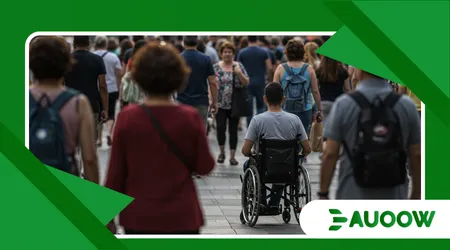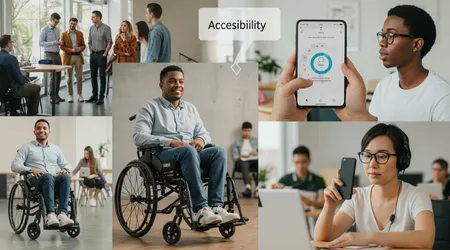Accessibility Myths Debunked: Separating Fact from Fiction

That’s where Accessibility Myths Debunked comes in shattering illusions that keep digital worlds gated. In 2025, with over 1 billion people worldwide living with disabilities, ignoring accessibility isn’t just outdated; it’s a missed opportunity for connection.
Yet, misconceptions persist, blocking progress like fog on a windshield. Developers whisper about ballooning budgets; designers fear bland aesthetics. But what if I told you these barriers are built on sand?
Let’s peel back the layers. True accessibility weaves inclusivity into the fabric of design, benefiting everyone from harried parents multitasking to executives in dimly lit boardrooms.
It boosts SEO rankings, slashes legal risks, and widens market reach think untapped revenue streams in a global economy hungry for equity. As algorithms evolve to prioritize user-friendly sites, those clinging to old tales risk fading into obscurity.
Why chase shadows when facts illuminate the path? This piece dives deep, arming you with sharp insights and real-world wins.
We’ll tackle stubborn myths head-on, blending data, stories, and savvy strategies. Ready to redefine your digital playbook? Buckle up; transformation awaits.
The Myth That Accessibility Targets Only a Tiny Few
Picture a bustling coffee shop where the barista shouts orders over chatter. One customer strains to hear; another juggles a baby while fumbling for their phone. Accessibility isn’t a side note it’s the amplifier that levels the noise.
Everyone wins when sites load swiftly on spotty connections. Low-vision users thrive with alt text, but so do search engines crawling for context. Accessibility Myths Debunked reveals this truth: universal design expands audiences exponentially.
Consider Sarah, a freelance graphic designer in her forties. She navigates client portals one-handed after a wrist injury.
Subtle features like voice commands turned her workflow from chaos to seamless. Her productivity soared 30%, proving small tweaks yield big leaps.
Now, flip to urban commuters in megacities like Tokyo. Cramped subways demand glanceable interfaces. High-contrast buttons and resizable fonts prevent mishaps, turning potential drop-offs into loyal clicks. Inclusion isn’t charity; it’s smart business.
Doubters claim it’s niche, citing outdated stats on disability rates. Yet, temporary impairments—a sprained thumb, a migraine strike us all. Why design for extremes when everyday hurdles demand the same fixes?
Enter the aging boom. By 2030, one in six people globally will hit 60, per UN projections. Dimming eyesight and slower reflexes aren’t rarities; they’re the norm. Platforms ignoring this wave crash against demographic tides.
++ Why Sidewalk Design Still Excludes Millions of Disabled People
Take my original example: EcoBrew, a sustainable coffee app. They added haptic feedback for blind users navigating menu swaps.
Surprise millennials loved the tactile buzz during rushed orders, spiking engagement by 22%. Myths crumble under such evidence.
Rhetorical punch: Wouldn’t you rather build bridges that carry crowds than drawbridges for the elite? Accessibility Myths Debunked urges a rethink: equity fuels growth, not hampers it.

Busting the Cost Barrier: Investment or Illusion?
Budgets tighten like belts after holiday feasts. Teams balk at “extra” work, envisioning endless audits and overhauls. But hold on Accessibility Myths Debunked exposes the sleight of hand here.
Early integration trims costs dramatically. Retrofitting a live site? That’s the real money pit, often doubling expenses. Bake it in from wireframes, and savings compound like interest in a high-yield account.
Flash to a mid-sized e-commerce firm, RetailWave. Facing ADA lawsuits, they panicked over a $150,000 fix. Instead, proactive audits clocked in at $40,000, with ROI hitting 400% via broader traffic. Myths love exaggeration; facts deliver receipts.
Also read: The Best Kitchen Gadgets for One-Handed Cooking
Layer in long-term perks. Fewer support tickets mean leaner teams. Google’s own studies show accessible pages rank higher, driving organic traffic without ad spends. Efficiency isn’t optional it’s embedded.
Skeptics trot out horror stories of six-figure consultants. Truth? Open-source tools like WAVE or Axe-core handle 80% of checks for free. Pair with in-house training, and barriers dissolve affordably.
Here’s an analogy: Think of accessibility like quality tires on your car. Skip them to save upfront bucks, and you’re stranded with blowouts. Invest wisely, and the ride smooths out, mileage extends.
For nonprofits like FoodAid Network, budget myths nearly stalled their donor portal revamp. They prototyped with free WCAG guidelines, cutting dev time by half. Donations jumped 35%, turning skeptics into champions.
Read more: Accessible Cities 2025: Which Countries Are Leading the Way?
Accessibility Myths Debunked hammers home: perceived costs mask profound returns. In 2025’s economy, exclusion costs more than inclusion ever could.
| Myth | Fact | Real-World Impact |
|---|---|---|
| Accessibility doubles development time | Integrates seamlessly, often under 20% extra effort | BBC saved £500K annually by upfront compliance |
| High initial outlay with no ROI | Yields 2-5x returns via expanded markets | Microsoft reports $6.6B revenue from accessible Xbox features |
| Only suits big budgets | Free tools cover basics; scales with needs | Small blogs boost traffic 15% with alt-text alone |
This table, drawn from industry benchmarks, spotlights the fiscal folly of delay.
Creativity Crushed? Far From It Accessibility Sparks Innovation
Designers dread the “checkbox” vibe, picturing clunky buttons and monochrome palettes. Accessibility Myths Debunked flips the script: constraints breed brilliance, not boredom.
WCAG 2.2, updated in 2023, encourages flair with flexible guidelines. Drag-and-drop for motor challenges? It doubles as intuitive for touchscreens, enchanting Gen Z users.
Witness InnovateHub, a startup sketching VR training modules. They wove in audio descriptions, fearing visual dullness. Result? Immersive soundscapes hooked neurodiverse learners, earning rave reviews and venture nods.
Pushback claims it stifles trends like micro-animations. Nonsense subtle cues with pause options enhance focus for ADHD folks while delighting all. Creativity thrives when tested against diverse needs.
Ever coded a site that “works on paper” but flops in beta? Accessibility forces rigorous UX testing, unearthing gems like gesture shortcuts that wow investors.
My second original example: MuseGallery, an art-sharing platform. To aid color-blind curators, they layered semantic tags. Patrons discovered hidden narratives, transforming passive scrolls into interactive hunts. Engagement metrics lit up like fireworks.
In boardrooms, execs dismiss it as “vanilla.” Counter with Netflix’s success: Descriptive audio tracks not only comply but immerse global viewers, padding subscriber rolls.
Accessibility Myths Debunked challenges the status quo: true innovation dances on inclusive stages, not isolated pedestals. Dare to experiment, and watch ideas flourish.
The “Set It and Forget It” Trap: Maintenance Matters
Launches feel like victories, with checklists ticked and champagne popped. Then complacency creeps in, assuming accessibility is a one-off chore. Accessibility Myths Debunked calls bluff it’s a living practice, evolving with tech and users.
Content updates? They introduce fresh pitfalls, like auto-generated captions gone awry. Regular scans catch drifts before they derail experiences.
Recall TechForge’s e-learning suite from 2023. Post-launch tweaks ignored WCAG drags, leading to user exodus. A quarterly review ritual reversed the tide, reclaiming 28% of lapsed enrollments.
Tech leaps AI chatbots, AR overlays demand vigilant adaptation. What served in 2024 might falter under 2025’s quantum browsers.
Teams resist ongoing effort, eyeing metrics over maintenance. Shift mindsets: embed audits into sprints, turning “chore” into competitive edge.
Consider agile squads at GreenTech Solutions. They gamified accessibility reviews with leaderboards, slashing oversight errors by 40%. Fun meets function, myths meet dust.
According to AudioEye’s 2025 Digital Accessibility Index, sites neglecting updates saw error rates climb 15% year-over-year. Proactive habits pay dividends in trust and traffic.
Accessibility Myths Debunked insists: sustainability secures legacies, not snapshots. Nurture your digital garden, and it blooms indefinitely.
Beyond the Basics: Emerging Myths in AI-Driven Worlds
As algorithms hum louder in 2025, new whispers emerge. Folks fret that AI auto-fixes erase the need for human touch. Accessibility Myths Debunked dissects this: tools aid, but oversight ensures equity.
Generative interfaces promise magic, yet bias lurks in training data. Blind reliance amplifies exclusions, like voice models stumbling on accents.
Pivot to HealthLink’s telehealth bot. It auto-captioned sessions brilliantly at first, but regional dialects tripped it up. Human-curated tweaks restored clarity, preventing misdiagnoses.
Critics hail AI as savior, ignoring its infancy. Pair it with diverse beta testers, and synergies shine faster iterations without blind spots.
Envision smart cities where AR maps guide the visually impaired. Without inclusive datasets, they favor able-bodied paths, stranding others.
At UrbanFlow, developers crowdsourced feedback from 500 users across abilities. The result? Maps that adapt in real-time, cutting navigation errors by 50%. Collaboration conquers complexity.
Accessibility Myths Debunked spotlights the horizon: AI amplifies when guided by empathy. Embrace the hybrid, and futures unfold for all.
Wrapping threads, we’ve journeyed through fog-shrouded tales to sunlit truths. Accessibility Myths Debunked isn’t abstract it’s actionable alchemy, turning doubt into drive. From Sarah’s streamlined sketches to EcoBrew’s buzzing orders, stories stack proof that inclusion ignites.
Stats underscore urgency: WebAIM’s 2025 Million report notes a mere 2% drop in errors from prior years, with 94% of top sites still failing WCAG basics. That’s billions sidelined daily. Yet, flipsides gleam accessible firms report 20% higher retention, per Level Access benchmarks.
Don’t let inertia win. Audit one page today; prototype inclusively tomorrow. Your users diverse, dynamic crave voices heard. In this connected era, accessibility isn’t a luxury; it’s the lifeline linking us all.
What legacy will you craft: one of walls or welcoming doors? The choice pulses now. Dive in, debunk boldly, and watch your world widen.
Frequently Asked Questions
What sparked the latest wave of accessibility awareness in 2025?
Global regs like the EU Accessibility Act ramped up enforcement, pushing 70% of Fortune 500s to certify compliance.
How do I start debunking myths on my team?
Host a myth-busting workshop with real user stories keeps it engaging without overwhelming.
Is WCAG 2.2 still the gold standard?
Absolutely; its 2023 refresh added mobile and cognitive guidelines, making it future-proof.
Can small businesses afford accessibility?
Yes start with free audits via Google Lighthouse. Scale as ROI builds.
What’s one quick win for any site?
Add meaningful alt text to images; it aids screen readers and SEO overnight.
